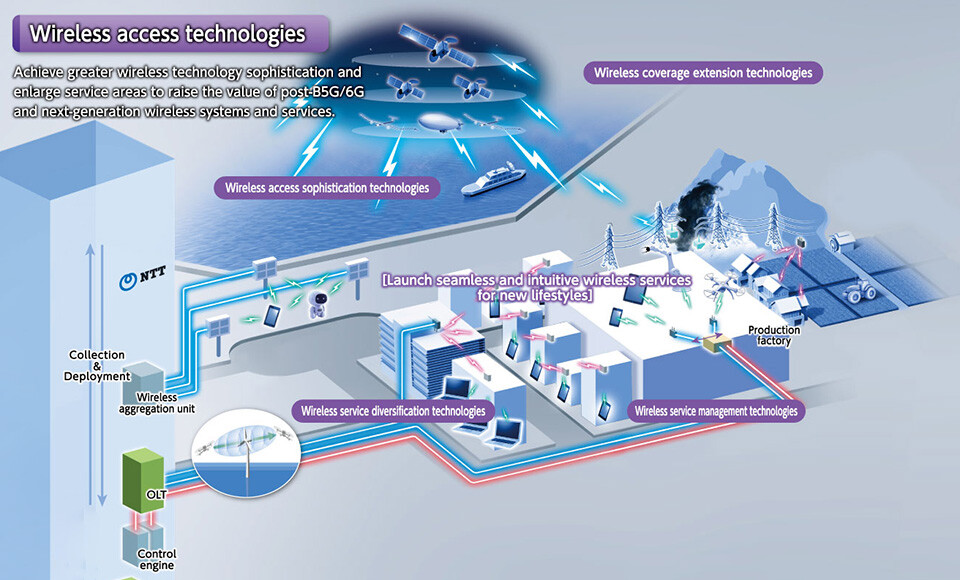Wireless access technologies
Launch seamless and intuitive wireless services for new lifestyles
Achieve greater wireless technology sophistication and enlarge service areas to raise the value of post-B5G/6G and next-generation wireless systems and services.
Action

Wireless coverage extension technologies
The NTT Group aims to use a multi-layer non-terrestrial network (NTN) consisting of satellites such as geostationary orbit satellites and low Earth orbit satellites and high-altitude platform stations (HAPSs) to expand coverage and provide a wide array of services. These will include IoT and in-aircraft communication services and disaster-relief communications in addition to telephone services.
To provide countermeasures to disasters, we are developing wireless systems in preparation of large-scale disasters based on a policy of "improve network reliability," "ensure critical communications," and "restore services early" as key objectives.
Wireless access sophistication technologies
The need for wireless communications as a communications infrastructure and associated usage scenarios continue to expand. At NTT Access Network Service Systems Laboratories, we are researching and developing advanced wireless access technology anticipating that the usage scenarios of wireless systems will expand toward Beyond 5G/6G and diverse next-generation systems. Main R&D themes include ultra-large-capacity wireless access networks for the Beyond 5G/6G era, wireless access systems using quasi-millimeter-wave and higher frequency bands, millimeter-wave access networks using analog Radio over Fiber (RoF), and next-generation wide-area wireless access networks.
Wireless service diversification technologies
User needs continue to diversify along with the explosive spread of smart terminals and IoT devices. Up to now, the emphasis has been on increasing communication speed, but from here on, it will be necessary to provide access circuits that can respond flexibly to a wide variety of needs that include not only "large capacity" but also "high reliability," "low latency," and "high quality." At NTT Access Network Service Systems Laboratories, we are researching and developing the use of unlicensed radio bands that are expected to be increasingly available to users in addition to cellular with the aim of enhancing user experience in diverse applications and achieving a corporate digital transformation.
Multi-radio proactive control technology (CradioⓇ)
In wireless communications, the arrival conditions of radio waves change from moment to moment owing to the movement of people, cars, etc. "CradioⓇ" is a term we created and is a general term for wireless control technologies such as multi-radio linking and control technology in NTT's Cognitive Foundation for proactively providing coverage that best fits ever-changing environmental and user conditions and achieving a communication environment in which the user need not be aware of the wireless network. Given a variety of wireless access systems including local 5G and wireless LAN, CradioⓇ achieves a natural communication environment in which the user has no need to worry about the wireless network by " understanding" radio conditions, "predicting" radio quality that changes from moment to moment, and "controlling" settings according to the environment and system requirements so as to satisfy application requirements in real time.
Reference video:Multi-radio proactive control technology (CradioⓇ)







